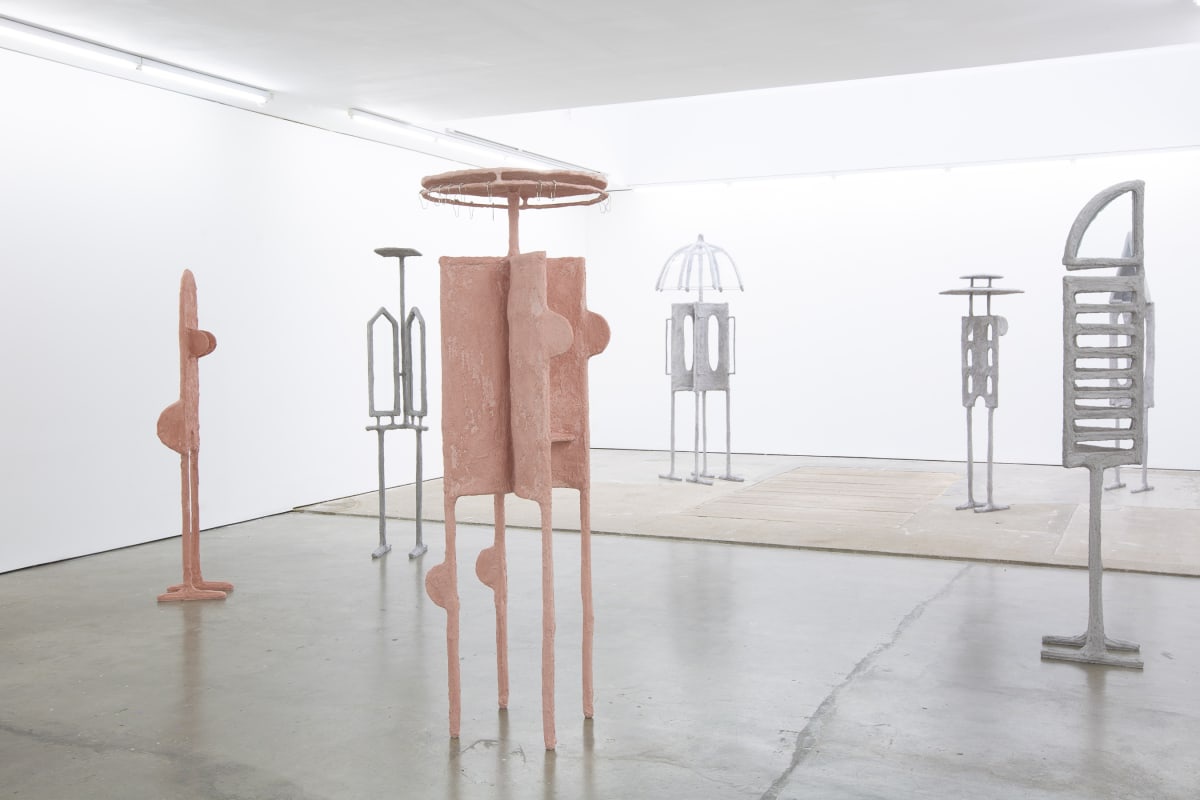01 May 2021 The anthropomorphic sculptures of Israel-born, New York-based Oren Pinhassi hold up a strange, disconcerting mirror to humanity. Though vaguely like us in appearance, their forms call to mind structures built for specific functions. If a voting booth or urinal, for instance, were to mate with a human, this is what their offspring might look like. Pinhassi has created humanoid sun loungers, green structures resembling plants crossed with parasol frames, and Perspex tables with orifices that allow sculptural forms to protrude suggestively from below. These sculptures fuse a suggestion of the corporeal with elements of furniture design, without being properly functional.

Oren Pinhassi, The Crowd, 2020
The Crowd, Pinhassi’s beguiling recent two-part show, was peopled with similarly hybrid sculptures. More figurative than some of his earlier works, these constructions all stand upright on legs. Bearing bulges where breats, buttocks, or knees might be and ribcage-like slats in place of torsos, some are painted flesh pink, others concrete gray. Each one hints at some sort of administrative function, with features such as a small ledge for filling in forms, panel windows, handles, or a letterbox-size slot. These totemic beings seem to invite interaction with one person at a time, even Duo and Duo (II), each one consisting of two single booths stuck back to back. Despite their rigidity and detachment, many of the figures are punctured with holes of various sorts, suggesting the possibility of intimacy with a foreign body through penetraton. Constructed from plaster and sand layered over welded steel armatures, the sculptures combine the rough texture of the handmade with the flatness fo the industrial.
The first iteration of The Crowd took place during Frieze Week inside the Victorian Church of St Cyprian’s in central London, and the second was installed in the white cube space of Edel Assanti gallery; the two venues offered distinct experiences of the sculptures. St Cyprian’s nondescript red brick façade belies an unexpectedly resplendent interior consisting of soaring gothic columns, generous windows, and a magnificent gilt-carved rood screen. Within this grandiose setting, Pinhassi’s flattened, stick-legged figures clustered in small groups about the nave, as if engaged in private, whispered conversations. The warm wooden parquet floor and rich, golden glints of the rood screen heightened an ambience of camaraderie. Some of the church’s architectural features found formal echoes in the sculptures, making them seem at one with the space - gothic arches, for instance, mirrored triangular elements in several of the totems. The presence of numerous columns inside the church reinforced the impression of a community or “crowd.”
By contrast, the works looked vulnerable within the gallery, stationed like isolated sentries around the low-ceilinged room. What was one to make of these stiff, gawky beings? While definitely not animate, they have an undeniably pareidolic aspect. As if to emphasize this, Pinhassi gave some of them human designations, including Magistrate and Sentinel. Against the austere white walls, the figures became more planar, their geometries thrown into relief. If there were a hierachy within the “crowd,” one might assume the two Duos would have authority over the rest, being larger, more three-dimensional and complex, one crowned with an umbrella, the other with a flat circular “hat” composed of a rail and hooks. This tension between flatness and solidity calls to mind Edwin A. Abbott’s 1884 novella Flatland: A Romance of Many Dimensions in which the protagonist, a square from the two-dimensional, totalitarian world of “Flatland” is initiated into the mysteries of three-dimensional “Spaceland”-and consequently imprisioned for apostasy. Pinhassi evokes a universe somwehere between Flatland and Spaceland inhabited by his strange creatures and invites us to ponder the implications of the increasing dissolution of boundaries between the human and the manufactured.



